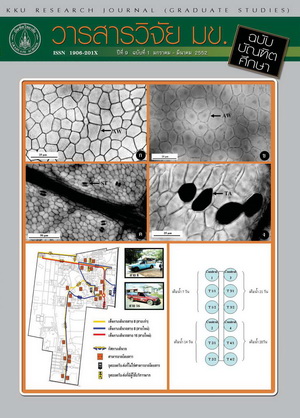ลักษณะเฉพาะด้านอำนาจแม่เหล็กตกค้างของอนุภาคแม่เหล็กนาโนสังเคราะห์ (Remanent Magnetization Characteristics of Synthetic Magnetic Nanoparticles)
Keywords:
Remanent magnetization(อำนาจแม่เหล็กตกค้าง), Magnetic hysteresis(ฮีสเตอรีซีสแม่เหล็ก), Superparamagnetic(แม่เหล็กพารายิ่งยวง)Abstract
สังเคราะห์อนุภาคแม่เหล็กนาโนจาก 3 วิธี ได้แก่ การตกตะกอนร่วมของสารละลาย FeSO4 กับ FeCl3 (วิธี A) การตกตะกอนร่วมของสารละลาย FeCl2 กับ FeCl3 (วิธี B) และ กระบวนการโซล-เจล (วิธี C) จากค่าสภาพรับไว้ได้ทางแม่เหล็กตั้งต้นของสารพบว่าอุณหภูมิ 400oC เป็นอุณหภูมิที่เหมาะสมสำหรับการสังเคราะห์ด้วยกระบวนการโซล-เจล ลักษณะเฉพาะทางแม่เหล็กตรวจสอบโดยการวัดค่าสภาพรับไว้ได้ทางแม่เหล็ก การศึกษาสมบัติฮีสเตอรีซิสแม่เหล็ก การเหนี่ยวนำและการลบล้างอำนาจแม่เหล็กตกค้างชนิดไอโซเทอร์มัล (IRM) และชนิดเทอร์มัล (TRM) พบว่าที่อุณหภูมิห้องสารแม่เหล็กที่สังเคราะห์จากทั้ง 3 วิธี แสดงสมบัติของโดเมนแม่เหล็กพารายิ่งยวดเป็นส่วนใหญ่ โดยมีโดเมนเดี่ยวเสถียรผสมเล็กน้อย สารแม่เหล็กที่สังเคราะห์ด้วยกระบวนการโซล-เจลจะมีสัดส่วนของอนุภาคแม่เหล็กพารายิ่งยวดมากกว่าการสังเคราะห์ด้วยวิธีการตกตะกอนร่วม
Magnetic nanoparticles were synthesized by three methods, namely, precipitation of ferrous sulfate/ferric chloride solution (Method A), precipitation of ferrous/ferric chloride solution (Method B), and sol-gel process (Method C). The magnetic susceptibility of synthetic particles prepared by sol-gel process showed that the annealing temperature of 400 ÌC was the optimum. Characterizations of the synthetic magnetic nanoparticles by using the measurement of the initial magnetic susceptibility, magnetic hysteresis, acquisition of the isothermal remanent magnetization (IRM) and thermoremanent magnetization (TRM), AF and thermal demagnetization of TRM and IRM showed that at room temperature, the synthetic magnetic nanoparticles prepared from the three methods were in the range of unstable single domain state or superparamagnetic with small amount of the stable single domain particles. The magnetic nanoparticles prepared by the sol-gel gave a higher proportion of superparamagnetic particles than those from co- precipitation routes.



